Key takeaways:
- Copyright grants creators exclusive rights to their original works, starting at creation without needing registration.
- Understanding “fair use” is crucial as it allows limited use of copyrighted material without permission, but its application can be complex.
- Copyright plays a vital role in research integrity by protecting intellectual property, ensuring proper attribution, and fostering collaboration.
- Common misconceptions about copyright include the belief that it lasts forever and that minor alterations to existing works are sufficient to avoid infringement.
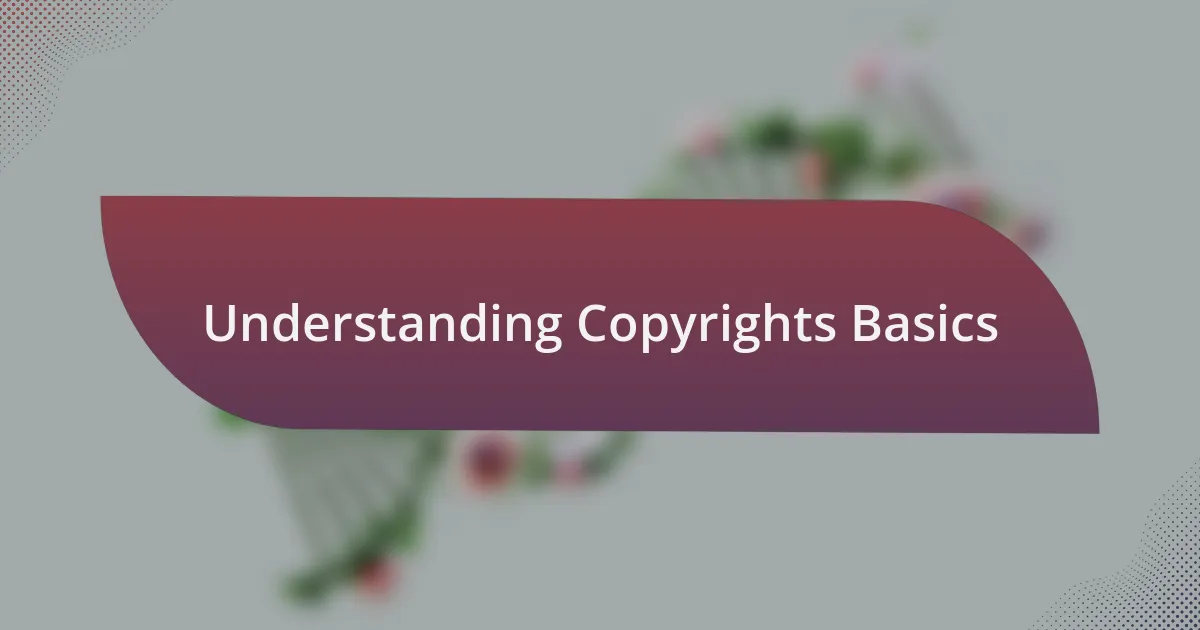
Understanding Copyrights Basics
Copyright is a legal framework that grants creators exclusive rights to their original works, which can be music, literature, art, or even software. When I first delved into the world of copyrights, I discovered that these rights begin the moment a piece of work is created, without the need for registration. It felt empowering to know that my words, once written, were automatically protected.
Understanding the nuances of fairness and usage can be daunting. I remember feeling overwhelmed when trying to grasp the concept of “fair use.” It’s a principle that allows limited use of copyrighted material without needing permission, but it’s not always straightforward. Have you ever wondered where that line is? From my experience, it helps to consider the purpose of use, the nature of the copyrighted work, the amount used, and the effect on the market value.
One aspect that surprised me was the length of copyright protection, which can last for the creator’s lifetime plus an additional 70 years. Imagine creating a piece of art that remains under your control long after you’re gone! It’s a comforting thought, but it also emphasizes the need for us to respect the works of others. After all, wouldn’t you want your creations to be valued and protected?
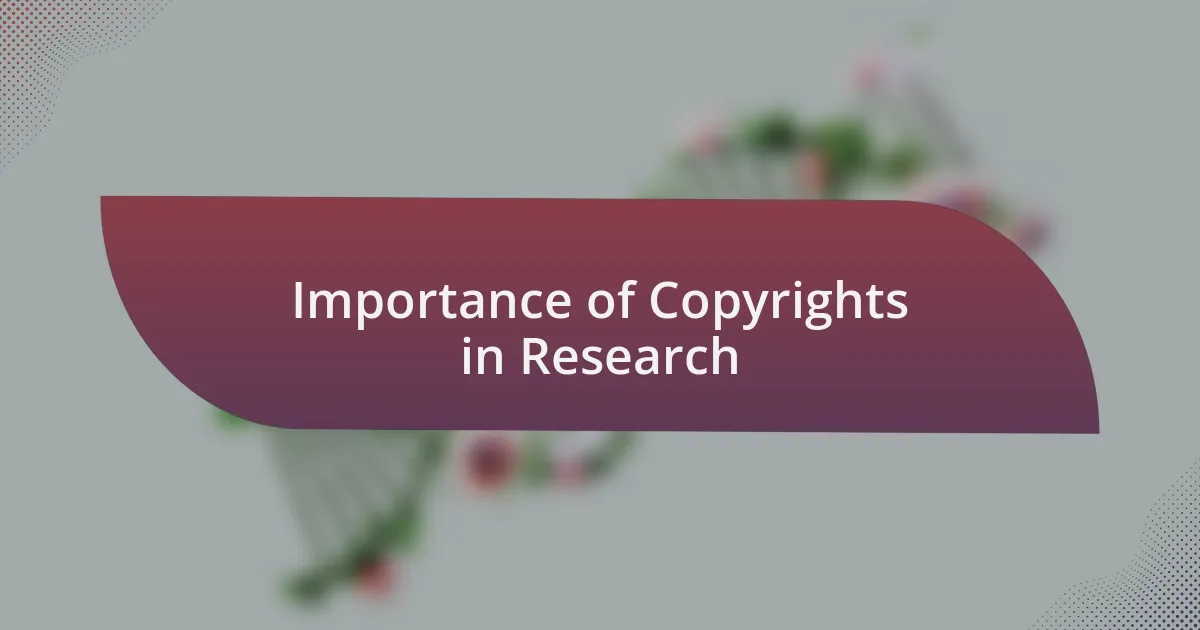
Importance of Copyrights in Research
Copyrights play a crucial role in research by protecting the intellectual property of scholars and authors. I recall a time in my academic career when I was navigating the complex landscape of publishing my findings. Understanding that I had the right to control how my work was used not only boosted my confidence but also motivated me to pursue my research with vigor. Without copyright protections, wouldn’t it be easy for someone to take your hard-earned findings and claim them as their own?
Additionally, copyright serves as a foundation for the integrity of research. When I think back to my early studies, I often worried about my work being misrepresented or taken out of context. Knowing that copyright laws required proper attribution helped ensure that researchers give credit where it’s due. It fosters an environment of trust, allowing collaboration and innovation to flourish—do you see how vital this trust is for academic growth?
Moreover, copyright encourages diversity of thought by enabling researchers to share their work confidently. I once collaborated with a team on a paper, and our discussions about copyright opened my eyes to the richness of our individual contributions. When creators feel their rights are protected, they’re more likely to share their ideas, enriching the field with multiple perspectives. Could the fear of losing acknowledgment stifle creativity? Absolutely, which is why copyright remains a cornerstone of research integrity.
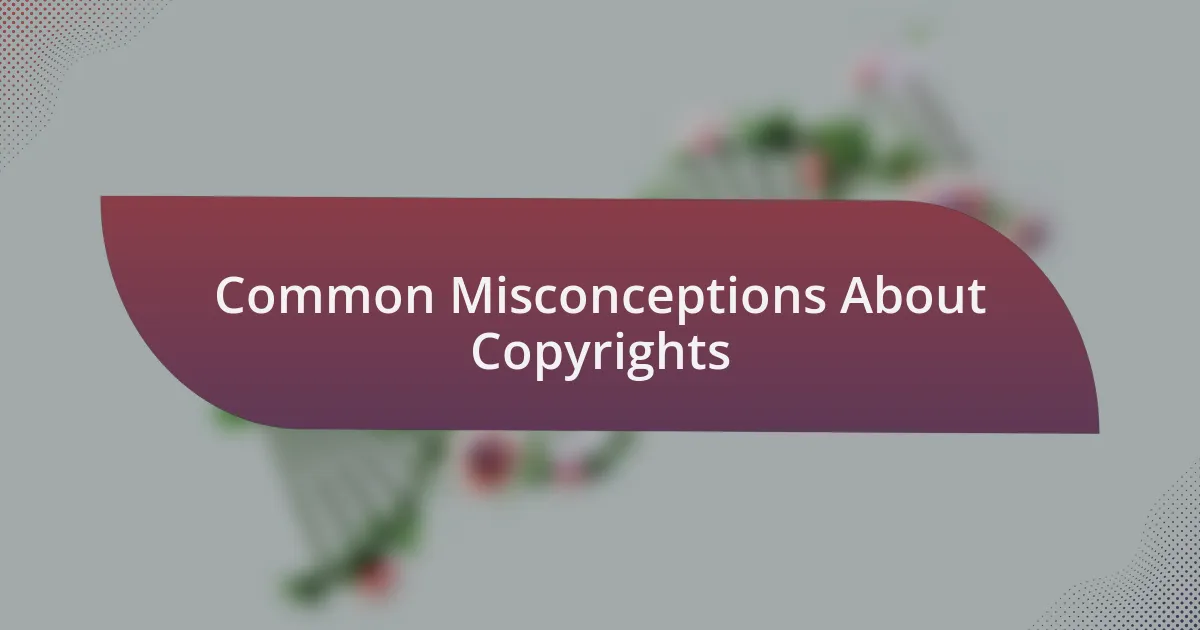
Common Misconceptions About Copyrights
Many people think that copyright covers all creative works as soon as they’re created, but that’s not always the case. I once believed that simply writing an article meant I was automatically protected. It wasn’t until I learned about the nuances of copyright registration that I realized how much more there is to safeguarding my work. Are we truly aware of the differences between copyright and simply having an idea?
Another common misconception is that copyright lasts forever, which can lead to confusion about ownership over time. I remember a time when I thought my research paper would be mine indefinitely; however, I discovered the important terms of copyright duration that dictate when a work enters the public domain. Wouldn’t it be helpful if more people understood these timelines? It’s crucial for anyone involved in creative fields to know when their work will no longer be owned and how that could impact their future endeavors.
Some may assume that changing a few words in an existing work makes it original enough to avoid copyright infringement. I’ve witnessed many friends struggle with this in their projects, believing a simple rephrase was sufficient. It’s a risky gamble, and often, the line between inspiration and plagiarism can blur. How can we expect to innovate if we don’t recognize the boundaries set by copyright? Understanding these misconceptions is essential for anyone looking to navigate the complex waters of intellectual property.
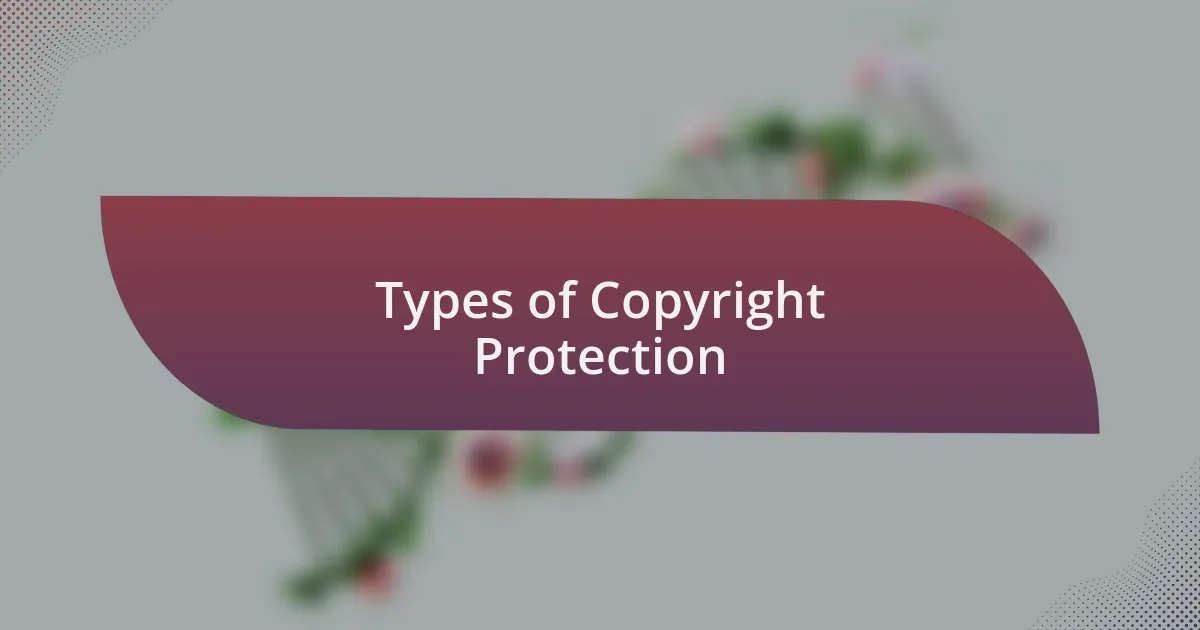
Types of Copyright Protection
Copyright protection comes in several distinct forms, each tailored to safeguard different types of creations. For example, literary works, music compositions, and visual art all fall under copyright, but they might require different approaches to protection. I remember when I published my first short story; the excitement was immense, but I soon realized I needed to delve deeper into how copyright applied specifically to written works.
Another key type of copyright protection involves derivative works. These are creations that are based on or inspired by existing works, such as adaptations of books into movies. I often think back to a documentary I worked on, where we used archival footage. Understanding how copyright affected our use of that material was crucial—if we mishandled it, our project could have faced significant legal hurdles. This aspect of copyright encourages creativity, yet it also demands respect for the original creators.
Lastly, we cannot overlook the significance of moral rights within copyright protection. This aspect allows authors to preserve their personal connection to their work, such as the right to attribution or the right to object to derogatory treatment. I once encountered a situation where a designer’s work was altered without permission, and the distress was palpable. It made me reflect on how vital it is for creators to know they have a voice regarding the treatment of their creations. Isn’t it empowering to know that these rights exist to protect not just the work, but the artist’s integrity too?
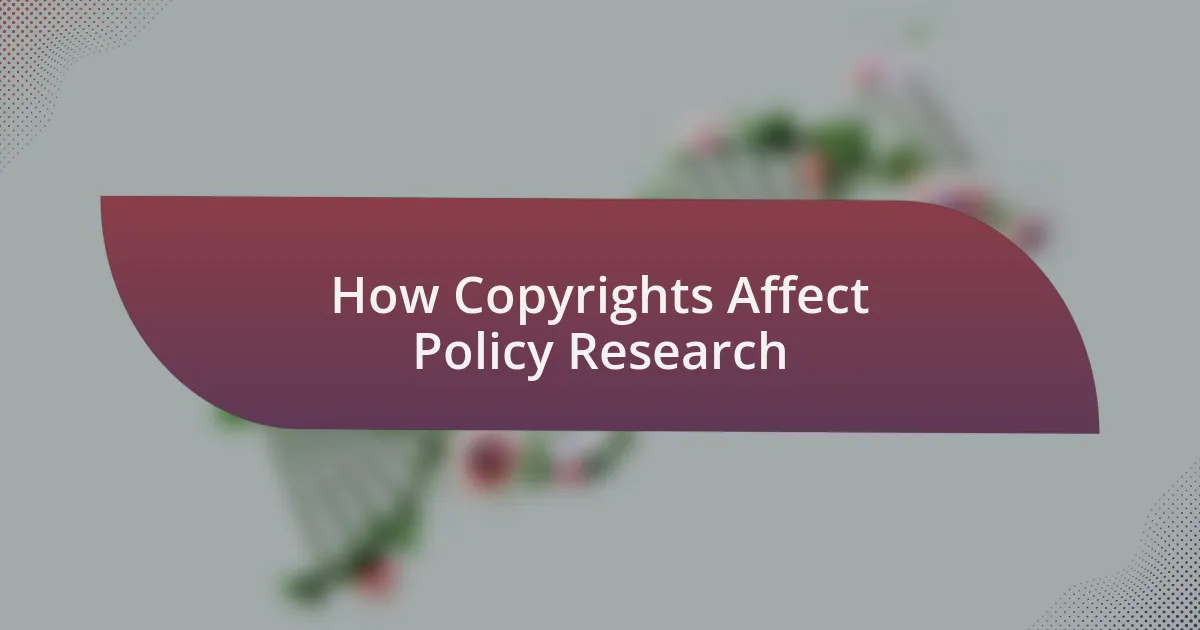
How Copyrights Affect Policy Research
Copyrights play a significant role in shaping policy research, as they dictate how researchers can use existing materials. For instance, when I was working on a research project involving previous studies, I found it crucial to understand copyright limitations. If I had improperly cited or used copyrighted materials, not only would the integrity of my research have been compromised, but I could have faced legal challenges too.
Understanding copyright laws has a lasting impact on collaboration within policy research. I recall collaborating with a team where each member contributed data and articles, and it was eye-opening to see how copyright ownership could complicate citation and credit. Why should researchers be hindered by copyright issues when sharing knowledge is the ultimate goal? The answer lies in fostering an environment where all parties are aware of their rights, ensuring that sharing data doesn’t lead to disputes.
Moreover, the digital age introduces unique challenges for policy research related to copyright. I once encountered a situation where my online research collections included various multimedia resources. Navigating the copyright implications of using these digital assets required diligence and proactive strategies. This made me realize that a robust understanding of copyright is not just beneficial—it’s essential for any researcher striving to uphold ethical standards while enriching their work. How have copyright issues influenced your own research endeavors? It’s something that continues to shape our academic landscape.
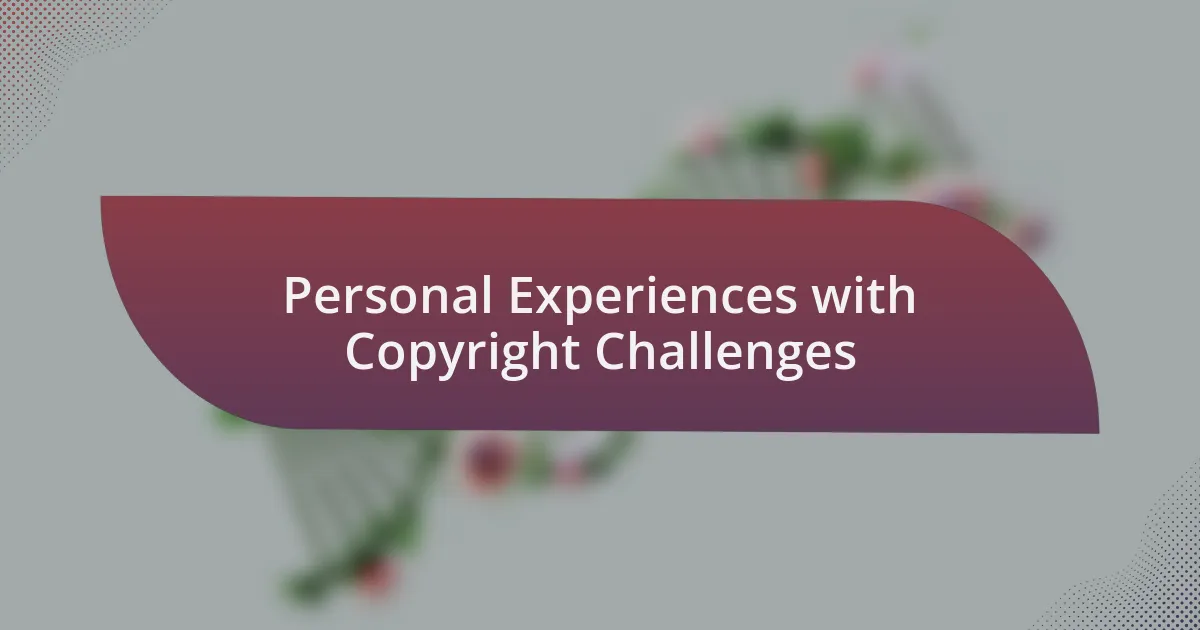
Personal Experiences with Copyright Challenges
Experiencing copyright challenges firsthand has often left me feeling overwhelmed. During a project where I wanted to incorporate an intriguing infographic, I quickly learned that using such visuals without permission could lead to serious repercussions. The thought of facing a lawsuit was daunting; it truly highlighted how vital it is to seek licenses even for seemingly minor resources. Have you ever faced a similar situation that made you rethink your approach to using existing materials?
I once had a co-author who was excited about using a well-known study to support our arguments. However, as we dove deeper into our work, we discovered that the original authors had specific restrictions on how their data could be shared. This not only delayed our project but also instilled a sense of frustration. It made me ponder how essential open access is for collaboration in our field—what could we achieve if sharing knowledge were easier?
Navigating copyright regulations can often feel like walking a tightrope. I remember dedicating hours to finding out if a particular article I had stumbled upon was under copyright protection. That sense of uncertainty can be paralyzing. I often wonder, how much innovation in policy research is stifled by complex copyright laws? The experience taught me that being proactive about copyright knowledge is indispensable for anyone eager to contribute meaningfully to our research community.

Tips for Navigating Copyright Issues
When navigating copyright issues, I’ve found that keeping meticulous documentation can be a game-changer. I still recall a time when I had to refer back to permissions for a series of images. Having clear records saved me from a potential misunderstanding that could have derailed my entire project. It really reinforced the idea that a little organization can go a long way in avoiding legal headaches.
Another tip that comes from my personal experience is to familiarize yourself with Creative Commons licenses. I once stumbled upon a wealth of resources under these licenses that allowed me to use and even modify materials freely. That revelation was eye-opening; it made me wonder what other hidden treasures are out there waiting to be discovered, as long as you know where to look.
One of the most valuable lessons I’ve learned is the importance of asking for permission upfront, even if the material seems trivial. There was an instance where I hesitated to reach out to an author for a quote I wanted to use. Ultimately, I discovered that the simple act of communicating can lead to fruitful collaborations and unexpected opportunities. How often do we let our fears of rejection hold us back from enriching our work?